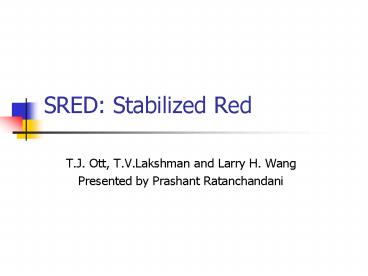SRED: Stabilized Red - PowerPoint PPT Presentation
1 / 24
Title:
SRED: Stabilized Red
Description:
Buffer Occupancy-Real Sources. Misbehaving Sources ... Total Occurrence is the sum over all zombies that have the same flow of (Count 1) ... – PowerPoint PPT presentation
Number of Views:20
Avg rating:3.0/5.0
Title: SRED: Stabilized Red
1
SRED Stabilized Red
- T.J. Ott, T.V.Lakshman and Larry H. Wang
- Presented by Prashant Ratanchandani
2
Main Idea
- Compare each arriving packet with a randomly
chosen packet that preceded it into the buffer - If both packets are of the same flow, declare a
hit - Estimate the number of active flows
- Find the candidates for a misbehaving flow
- J out of K hits information
3
Zombie List
- List of M recently seen flows
- Longer memory than the buffer alone
- Information for each zombie
- Countnumber of packets this zombie received
- Timestamp arrival time of most recently received
packet
4
Zombie List Operations
- While the zombie list is not full, add the packet
flow identifier to the list, increment count and
set timestamp - Zombie list is full
- Each arriving packet p compared with randomly
chosen zombie - If(hit) countcount1
t timestamptimestampp - If (!hit)
- with probability P, overwrite the flow
identifier of zombie with arrived packet - Packet may be dropped irrespective of a hit or not
5
Intuitive Argument
- Zombie list likely to lose memory every M/p
packets, M being the length of the zombie list - Fewer active flows imply there will be more hits
- Misbehaving flows shall cause more hits than
well-behaved ones
6
Hits and Active Flows
- P(t)-estimate for the hit frequency at the
arrival of the t-th packet at the buffer - Hit(t)0, if no hit 1, if hit
- P(t)(1- ?)P(t-1)?Hit(t)
- For example ?p/M
- P(t) is an estimate of the frequency of hits for
approximately the most recent M/p packets before
packet t
7
Proposition
- P(t)-1 is a good estimate for the effective
number of active flows in the time shortly before
the arrival of packet t
8
Supporting argument
- P(arrived packet belongs to flow i)?i
- Zombie represents flow I with probability ?i
- Thus probability that the packet shall cause a
hit P(Hit1)?(?i2) - Assuming N flows of identical traffic intensity
(?i1/N) P(Hit1)1/N
9
Proposition-Supporting Arguments
- P(t)-1 is an estimate of the effective number of
active flows even in the asymmetrical case - If ?I2-I then EP(t)3/16
- Flows taking more than 3/16 of the average
bandwidth are taking their fair share and flows
less than 3/16 are taking their fair share - If N flows with probability ?I then
1/Nlt?(?i2)lt1 - Update P(t) after every L packets
- P(new)(1-L?)P(old) ?H
10
Simple SRED
- Target buffer occupation Q0
- Set a drop probability p
- Square root law congestion window of each flow,
cwnd ?p-1/2 MSSs - Sum of N congestion windows N.p-1/2
- Q0 N p-1/2? p (N/ Q0)2
- p is proportional to N2
11
Candidate Probability Drop Function
- Buffer capacity B bytes
- Psred(q)pmax if B/3ltqltB pmax/4 if
B/6ltqltB/3 0 if 0ltqltB/6 - Pmax chosen to be 0.15
- On packet arrival P(t) is updated
- Pzappsred(q)X min(1,1/(256 X P(t))2)
12
Probability function(contd.)
- psred has only three possible values
(0,pmax,pmax/4) - psred depends only on the instantaneous buffer
occupation q - When 1/256ltP(t)lt1 pzap(psred/65,536)X(number
of flows)2 - When 0ltP(t)lt1/256 pzappsred
- If p becomes very large TCP sources spend most of
the time in time-out - When P(t) becomes small estimating P(t) is
unreliable
13
Full SRED
- Pzappsred(q)X min(1,1/(256 X P(t))2)X(1Hit(t)/P(
t)) - The old pzap is multiplied by
- 1 ?I/ ?(?j2)
- Increases the drop probability for overactive
flows and reduces TCPs bias for flows with short
RTTs
14
Simulation ResultsSymmetrical network
- Pmax0.15
- Transfer of infinitely large file
- Buffer occupancy below or slightly over B/3
- Loss always due to RED or SRED, and not buffer
overflow - Buffer occupancy for Nlt256 is independent of the
number of flows
15
Simulation Results-Symmetrical network
- Buffer occupancy for Ngt256 increases with the
number of flows. - Buffer occupation almost always never decreases
below B/6, where pzap0
16
Comparison-RED and SRED
17
Comparison-RED and SRED
- For RED, the buffer occupancy increases with the
number of connections - SRED buffer occupancy is at least B/3
18
Asymmetrical Network Simulations
- Connections with shorter round trip times get
higher throughput - Full SRED reduces this advantage by a small
amount - Full SRED is better when the number of active
connections decreases - Simple SRED and Full SRED both equally effective
in stabilizing buffer occupation
19
Realistic Source Model
- 2000 sources
- 200-400 active at a time
- P(t)-1 underestimates the number of active
flows - Many flows supposed to be active are not active
yet, or not active anymore - Active connections have varying congestion
windows
20
Buffer Occupancy-Real Sources
21
Misbehaving Sources
- Hit mechanism is used to identify candidates for
misbehaving flows - A flow taking more than its fair share is a hit
with a high Count for the zombie - Total Occurrence is the sum over all zombies that
have the same flow of (Count1) - Mechanisms are used to filter flows and find the
misbehaving subset
22
Differences with RED
- SRED estimates number of active flows
- Misbehaving flows can be identified without
keeping per-flow state - Drop probabilities are adjusted according to
number of active flows - No computation of average queue length
- Only TCP flows are assumed
23
Main Contributions
- SRED provides a mechanism to estimate number of
active flows and identify misbehaving flows - SRED controls buffer occupancy by adjusting drop
probabilities using estimated number of active
flows
24
Future Work
- Parameter Tuning(pmax and psred)
- Research on how to declare a flow as misbehaving































